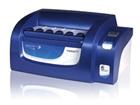Description
THE MICRORHEOMETER IS THE PARTICLE
Microrheology
Microrheology consists in using micron sized particles* to measure the local deformation of a sample resulting from an applied stress or simply due to thermal energy (Brownian motion).
This local probing method gives access to rheological properties characterized by :
Elastic modulus G’µR
Viscous modulus G’’µR
*i.e.: particles contained in the liquid dispersion (emulsions, suspensions,foams).
RHEOLOGY AT THE MICRON SCALE
Microrheology is a new domain of Rheology, which studies viscoelastic materials at the micrometer length scale. This complementary technique is powerful to analyse the viscoelastic structure of soft materials like colloids, polymers, gels, emulsions.
Rheology is the study of flow and deformation of materials in response to an applied stress. For complex viscoelastic systems, small deformation measurements reveal both the solid-like and fluid-like responses. This is usually performed by oscillatory mechanical rheometers which apply a small amplitude shear strain or stress, thereby ensuring linear response. These instruments require a strong expertise of the operator.
Rheolaser™ developed by Formulaction uses the passive microrheology technique to analyse soft materials like colloids, polymers, gels, emulsions...
PASSIVE MICRORHEOLOGY
No external stress is applied (measurement at rest). The local force acting on the particle is due to thermal energy (Brownian Motion) and the response is measured by probing the time-dependent Mean Square Displacement of the particle (MSD).
For instance, the displacement of the particles in a purely viscous fluid grows linearly in time, whereas in an elastic fluid the particles are limited in their displacement.
MSD IS THE MASTER CURVE TO ACCESS RHEOLOGICAL PROPERTIES
Using the Generalized Stokes Einstein Relation (GSER), it is possible to calculate from MSD curve:
The Elastic modulus G’µR versus the frequency
The viscous modulus G’’µR versus the frequency
Using Generalized Maxwell model, it is possible to calculate the relaxation time, the macroscopic viscosity and the plateau elasticity Gp’µR . These parameters enables to determine microstructure property like the mesh size.
Passive microrheology has been extensively studied by D. Weitz - Harvard University and T. Mason - UCLA University, et. al in the 1990’s.
PASSIVE MICRORHEOLOGY BENEFITS
MEASUREMENT AT REST
Viscoelastic properties are measured without applying any external stress.
Measurements are always in the Linear ViscoElastic Regime (LVER).
No changes in the sample structure due to an externally applied stress.
MICROSTRUCTURE ANALYSIS
Particles probe the local microstructure and characterize
Mechanical properties :elasticity and viscosity
Structural properties : relaxation time, mesh size
SENSITIVITY
The particle displacement measurement is highly sensitive (nanometer range), which allows detection of small deformations of the microstructure.
Microrheology : A new way of investigating soft materials


